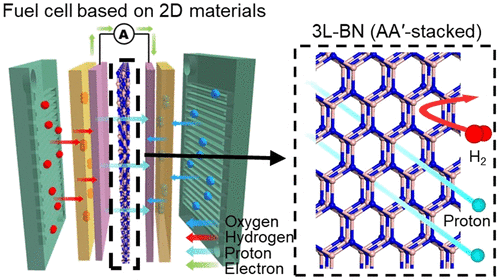Our official English website, www.x-mol.net, welcomes your
feedback! (Note: you will need to create a separate account there.)
AA′-Stacked Trilayer Hexagonal Boron Nitride Membrane for Proton Exchange Membrane Fuel Cells
ACS Nano ( IF 15.8 ) Pub Date : 2018-10-17 00:00:00 , DOI: 10.1021/acsnano.8b06268 Seong In Yoon 1 , Dong-Jun Seo 2 , Gwangwoo Kim 1 , Minsu Kim 1 , Chi-Young Jung 2 , Young-Gi Yoon 2 , Sang Hoon Joo 3 , Tae-Young Kim 2 , Hyeon Suk Shin 1
ACS Nano ( IF 15.8 ) Pub Date : 2018-10-17 00:00:00 , DOI: 10.1021/acsnano.8b06268 Seong In Yoon 1 , Dong-Jun Seo 2 , Gwangwoo Kim 1 , Minsu Kim 1 , Chi-Young Jung 2 , Young-Gi Yoon 2 , Sang Hoon Joo 3 , Tae-Young Kim 2 , Hyeon Suk Shin 1
Affiliation

|
Hexagonal boron nitride (h-BN) and graphene have emerged as promising materials for proton exchange membranes because of their high proton conductivity and chemical stability. However, the defects and grain boundaries generated during the growth and transfer of two-dimensional materials limit their practical applicability. Here, we report the fabrication of membrane electrode assemblies using large-area single-oriented AA′-stacked trilayer h-BN (3L-BN), which exhibits very few defects during the growth and transfer, as a proton exchange membrane for use in fuel cell systems. The fuel cell based on AA′-stacked 3L-BN showed a H2 permeation current density as low as 2.69 mA cm–2 and an open circuit voltage (OCV) as high as 0.958 V; this performance is much superior to those for cells based on Nafion (3.7 mA cm–2 and 0.942 V, respectively) and single-layer h-BN (10.08 mA cm–2 and 0.894 V, respectively). Furthermore, the fuel cell with the AA′-stacked 3L-BN membrane almost maintained its original performance (OCV, maximum power density, and H2 permeation current density) even after 100 h of an accelerated stress test at 30% RH and 90 °C, while the fuel cells with the Nafion and single-layer BN membranes exhibited severely deteriorated performances. The stability of the cell based on the AA′-stacked 3L-BN membrane was better because the membrane prevented gas crossover and suppressed the generation of reactive radicals during cell operation.
中文翻译:

质子交换膜燃料电池用AA'-叠层三层六方氮化硼膜
六方氮化硼(h-BN)和石墨烯因其高质子传导性和化学稳定性而成为有前途的质子交换膜材料。然而,在二维材料的生长和转移过程中产生的缺陷和晶界限制了它们的实际适用性。在这里,我们报道了使用大面积单向AA'堆叠三层h-BN(3L-BN)制造膜电极组件的过程,该膜电极组件在生长和转移过程中几乎没有缺陷,用作质子交换膜燃料电池系统。基于AA'堆叠的3L-BN的燃料电池的H 2渗透电流密度低至2.69 mA cm –2开路电压(OCV)高达0.958 V;该性能远远优于基于Nafion(分别为3.7 mA cm –2和0.942 V)和单层h-BN(分别为10.08 mA cm –2和0.894 V)的电池。此外,带有AA'堆叠的3L-BN膜的燃料电池几乎保持了其原始性能(OCV,最大功率密度和H 2渗透电流密度),即使在30%RH和90°C下进行了100个小时的加速应力测试后,带有Nafion和单层BN膜的燃料电池的性能也严重恶化。基于AA'堆叠的3L-BN膜的电池稳定性更好,因为该膜可防止气体交叉并抑制电池运行过程中反应性自由基的产生。
更新日期:2018-10-17
中文翻译:

质子交换膜燃料电池用AA'-叠层三层六方氮化硼膜
六方氮化硼(h-BN)和石墨烯因其高质子传导性和化学稳定性而成为有前途的质子交换膜材料。然而,在二维材料的生长和转移过程中产生的缺陷和晶界限制了它们的实际适用性。在这里,我们报道了使用大面积单向AA'堆叠三层h-BN(3L-BN)制造膜电极组件的过程,该膜电极组件在生长和转移过程中几乎没有缺陷,用作质子交换膜燃料电池系统。基于AA'堆叠的3L-BN的燃料电池的H 2渗透电流密度低至2.69 mA cm –2开路电压(OCV)高达0.958 V;该性能远远优于基于Nafion(分别为3.7 mA cm –2和0.942 V)和单层h-BN(分别为10.08 mA cm –2和0.894 V)的电池。此外,带有AA'堆叠的3L-BN膜的燃料电池几乎保持了其原始性能(OCV,最大功率密度和H 2渗透电流密度),即使在30%RH和90°C下进行了100个小时的加速应力测试后,带有Nafion和单层BN膜的燃料电池的性能也严重恶化。基于AA'堆叠的3L-BN膜的电池稳定性更好,因为该膜可防止气体交叉并抑制电池运行过程中反应性自由基的产生。











































 京公网安备 11010802027423号
京公网安备 11010802027423号